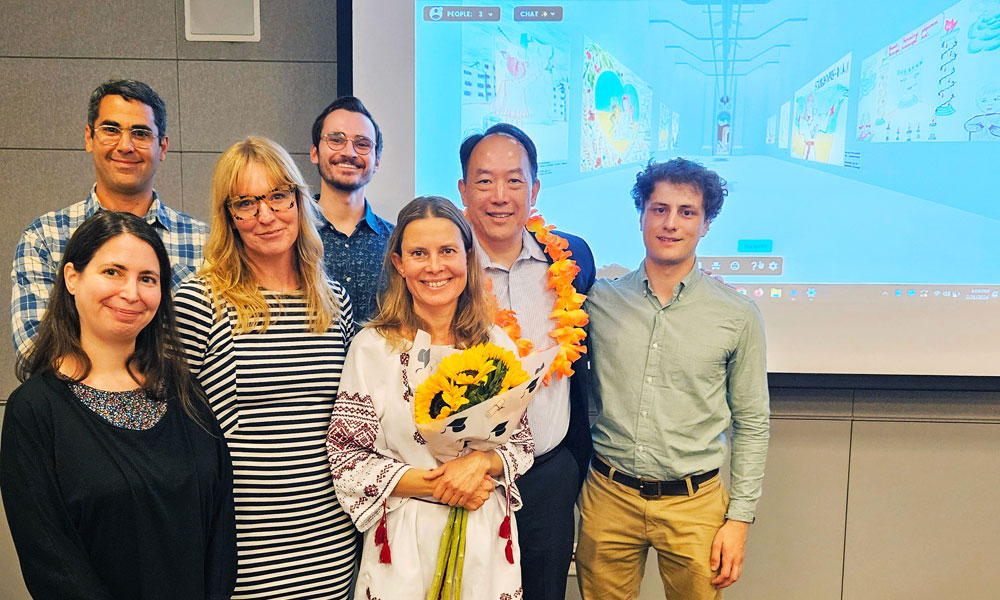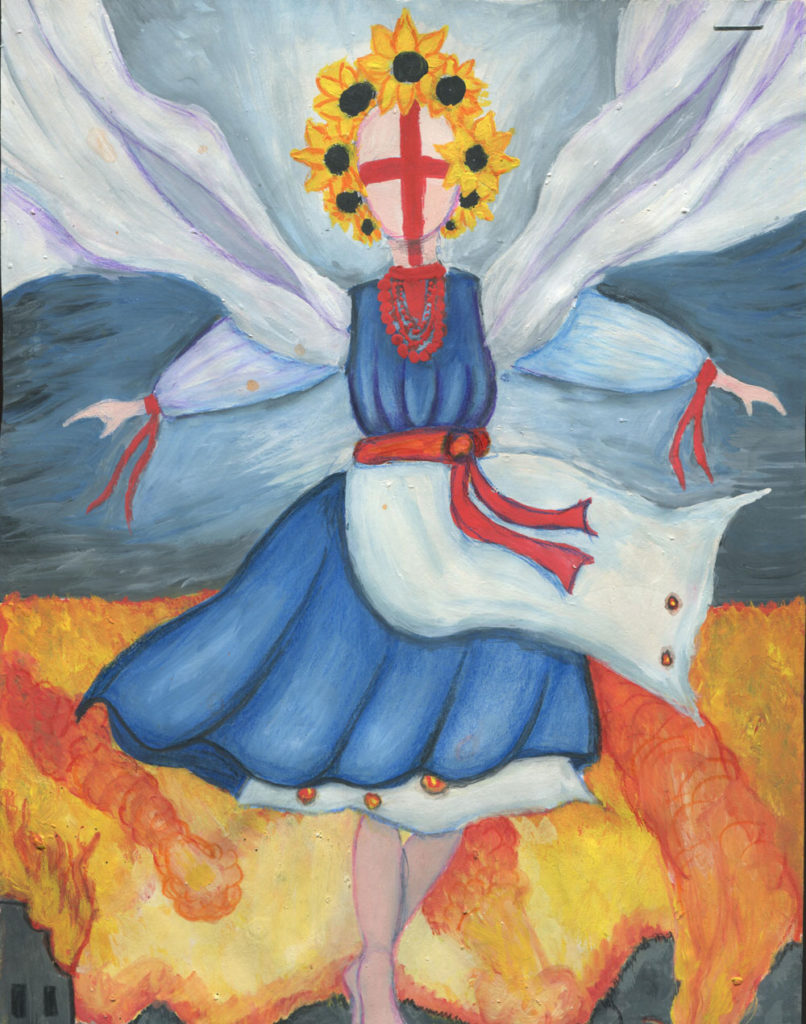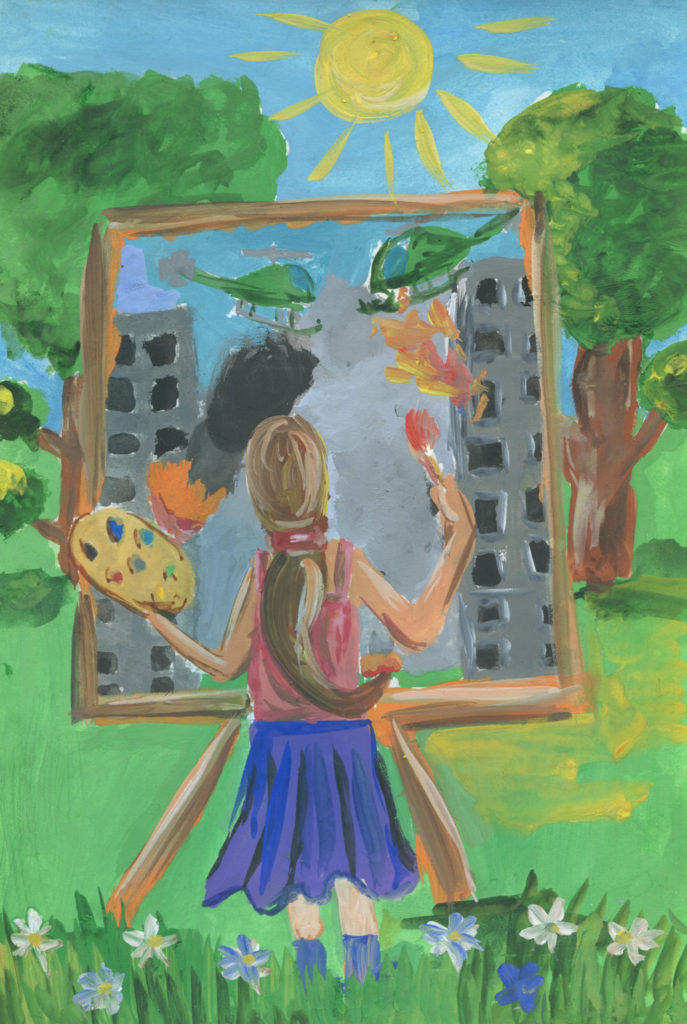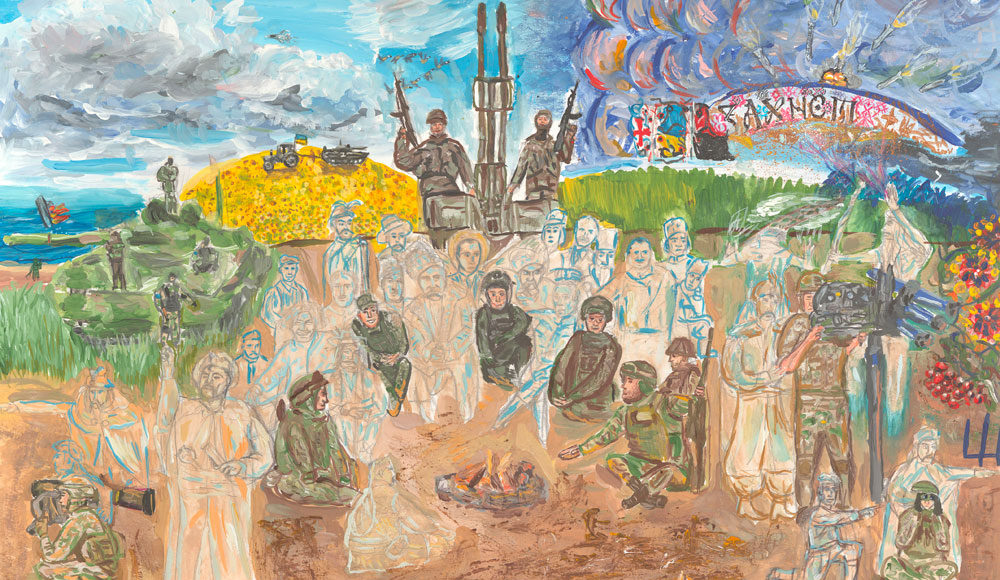Located just in front of San Jose State University School of Information sits the Victory Salute statue depicting SJSU students Tommie Smith and John Carlos at the 1968 Olympics. “It is nearly impossible not to see and look at it every time I enter and leave the building,” says Anthony Chow, who has been the director of iSchool (as it’s known) since 2021. For him, it’s a reminder of iSchool’s tradition “to stand up for others.”
Chow and several of his colleagues recently got a chance to honor that tradition, and the results of their work is on view now in an exhibit titled “Children Draw War, Not Flowers,” on view through June 24 at Martin Luther King Jr. Library on the SJSU campus.
The catalyst for the exhibit was Ulia Gosart, who joined iSchool in 2022, around the time that Russia invaded her homeland. Gosart came from the Cherkasy region in central Ukraine, where more than 225,000 citizens congregated after they were displaced by attacks by Russian troops—including 42,805 children. She was in contact with local librarians, who sought help to raise money for a scanner so they could digitize artifacts of Ukraine’s cultural heritage.
“Myself and another faculty member, Dr. Sue Alman, helped Ulia set up a GoFundMe account and we raised over $7,000,” Dr. Chow explained.
These librarians were doing more than just protecting books and other cultural riches: they also literally sheltered citizens during Russian attacks. And to provide some art therapy, the Ukrainian Library Association sponsored a drawing contest for children ages 4 to 16 that involved 40 libraries.


“Every drawing was displayed in Cherkasy in the library, and winners were announced and then the whole collection was digitized with the scanner that we bought for them,” Gosart explains. All 450 images can be found in the digital archive Save Ukrainian Cultural Heritage Online.
A second GoFundMe is now active, this time raising $1,000 each for libraries in seven different Ukrainian villages to purchase children’s books.
Hope Amid Despair
Seventy of the works are now on view at MLK Library in the exhibit curated by graduate student assistant Sara Clair. In addition to the machinery of war—aerial bombing, armed soldiers, military helicopters, explosions and flames—there are also images of hope: angels, sunflowers, storks, flowers, and the blue and yellow colors of the Ukrainian flag, all of which symbolize cultural resistance.
“Younger children draw weapons and battlefields,” Gosart says. “The older children have more complex depictions … more abstract. But little kids draw something they saw or experienced. To be able to actually have a physical connection with that historical evidence, by … thinking about this picture as something that has been produced a few years ago by a little child, is a very different way of understanding the war.”
One of the older children—Nazar, age 16—created a work that won plaudits from the Ukranian government. Titled “Guardian angels next to defenders,” the big historical piece shows Ukrainian soldiers next to famous writers, political figures from different times of Ukrainian history. The work stresses that Ukraine “not only has its own history, its own culture, but also a strong identity as a nation—and this is what the Russian government denies Ukraine,” Gosart says. “It was almost like a political statement, depicting all these components of history and culture that are significant for the nation to exist.”


Plans are in the works to make “Children Draw War Not Flowers” a traveling exhibit, with Syracuse University as a possible next stop. But to ensure that its reach immediately extends beyond MLK Library, Dr. Chow says, he asked the iSchool’s VR team, “consisting of our VR student assistant, Kelly Rausch, and our amazing VR consultant XRLibraries, to create the VR space.” This virtual gallery can be accessed anywhere in the world just using a browser. (Note: Those who aren’t accustomed to such online virtual explorations would do well to first move into the middle of each room and then begin perusing the work.)
Saving a Heritage
Rausch says that in addition to the primary goal to “reach a wider audience to give the children more room, more voice, to be heard and seen,” the VR exhibit also includes elements that put the artwork into context. A map shows the conflicts along Ukraine’s border, and immersive videos document scenes of combat and aerial bombardment, and separate rooms document the destruction of three major libraries—including the Chernihiv Regional Youth Library, a Neo-Gothic architectural wonder that survived Bolshevik and Nazi bombs.
“Documentary footage allows us to tell the story of cultural heritage institutions during wartime. They’ve been intentionally targeted because they house Ukrainian cultural identity and history,” Rausch says. “We don’t really think of librarians as being part of war efforts. … how deeply embedded they are in protecting the cultural heritage and spaces and countries.”
For the VR technology, SJSU partnered with XRLIbraries, which helps schools and libraries integrate immersive learning into programs. “Tim Bartolf of XRLibraries was very much a part in helping me build this space,” Rausch says. Toward the end of June, she and Clair and Gosart will team up with XRLibraries executive director John MacLeod to present their work at the American Library Association’s annual conference.
“COVID really changed VR. It was moving quite slowly and it got a quick push,” Rausch says. “It’s also getting a push through AI, which is making it easier and faster to create spaces and imagery. There’s a lot more of this ahead, I guarantee it, and it’s just a privilege to be part of it.” She adds, “Dr. Chow understands that this is a part of information science and technology. People are confused why libraries would be dabbling with VR but its applications are huge and the library’s history with digital literacy has always been there. The first place anybody could go to the internet was in the library.”


An elementary school librarian as well, Rausch says she showed some students the VR exhibit. “They have never been more engaged in anything that I have tried to show them or teach them. They were so quiet and so intent and so curious, and they were just floored by the imagery that the kids were creating,” she recalls.
“It’s been one of the most impactful projects I’ve ever worked on,” Rausch asserts. “I think it makes what is happening in Ukraine physically tangible here in the United States. Everybody has kind of forgotten about it.”
Eyewitnesses to History
For Gosart, forgetting about the conflict in Ukraine is impossible. She still has close ties to her homeland and is in constant contact with friends. “A few people told me, especially at the beginning, this is not a good cause. Who thinks about libraries when people are dying and houses are being destroyed?” But she points out that libraries serve as defenders of truth in a war in which disinformation is a major weapon brandished by Russia.
Gosart recalls listening to an interview with an 8-year-old girl who had depicted images of bombs falling while civilians—pictured as stick figures—cowered underground in bomb shelters. The girl said she wanted to depict “fear and anxiety that some people feel,” but asserted her belief in the Ukrainian Armed Forces and her hopes for victory and her father’s return from the front lines. “Every time I talk about this I start crying,” Gosart says, explaining that the child’s father was killed a couple of months ago.
While the drawings function as a form of art therapy, allowing the children affected by war to process their experiences, Gosart explains that she has another use for them in mind. “For me, why I wanted to do this and why I pressed on digitizing every single item and creating a collection of these items, I wanted to have evidence of the war crimes to be made, first of all, and collected to be preserved primarily with the hope of using these drawings as evidence of the war crimes that could be used at international tribunals.”


She points out that drawings by children in Darfur were accepted in 2007 by the International Criminal Court as contextual evidence of crimes committed in the country.
”I also worked in Kosovo after the war and I collected drawings from children. The themes and the colors are quite similar,” Gosart explains. “That was something that I had in mind and I still have in mind because I believe that these are very powerful eyewitness reports of crimes against the most vulnerable.”
But in the meantime, she believes these drawings can help people gain some understanding of what life during wartime is really like. “To read about it is one thing, but to actually see what’s happening on the battlefields or to see people being wounded or the city being occupied is quite powerful.
“This is what contemporary warfare is all about,” Gosart says. “It’s something that we have to learn how to deal with and learn how to stop as a global community, or to lessen the impact of this horror on civilians—and children particularly.”
Explore the VR exhibit of Children Draw War, Not Flowers.
See all 450 images in the SUCHO gallery.
Donate to a GoFundMe to support book purchases for Ukrainian libraries.



